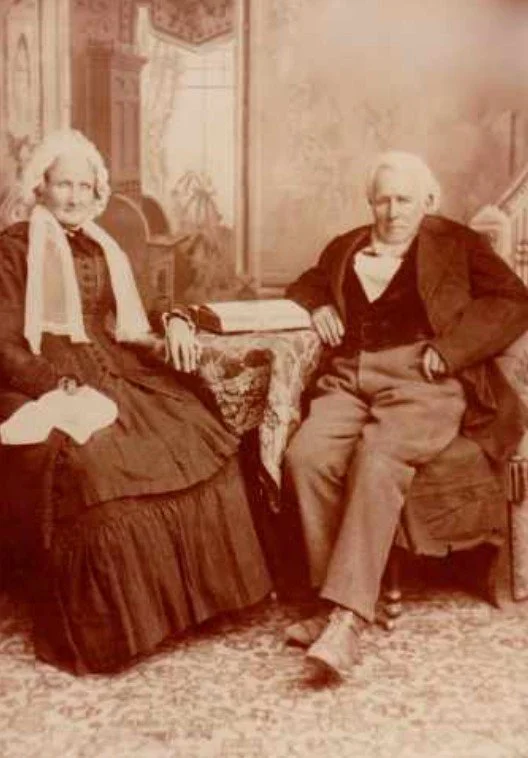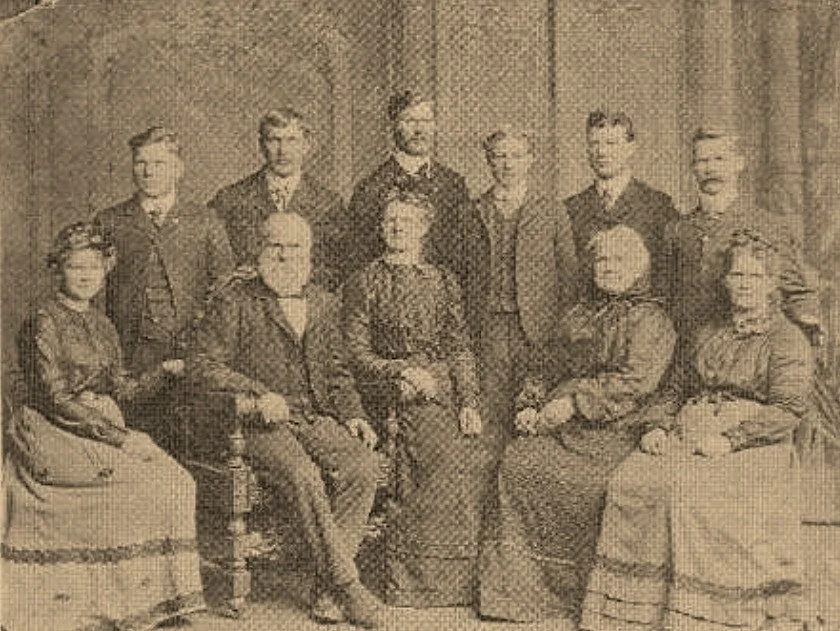West of Redwood road and 3300 south: The Duncombe Homestead
The original Duncombe homestead was located on what is now the west side of the Salt Lake Valley, in the heart of what became Granger (now part of West Valley City). Joseph Duncombe’s land was homesteaded along what is today Redwood Road (1700 West) and approximately 3300 South, a fertile area with good water access that was well suited for farming.
Joseph Duncombe (1806–1888) and Elizabeth Glover Duncombe (1815–1895)
Joseph Duncombe was born March 15, 1806, in Willenhall, Staffordshire, England. He married Elizabeth Glover in 1833 when he was 27 and she was just 18. Together they raised 14 children, though heartbreak touched their large family often — six of their children died young. The Duncombes worked hard to provide for their family; Joseph labored as a stone miner, coal miner, and tinker for a mining company. Their family embraced the teachings of The Church of Jesus Christ of Latter-day Saints when the missionaries arrived in Staffordshire, and like so many converts, they longed to gather with the Saints in Utah.
The Duncombes and their children left for America in small groups. Joseph and Elizabeth arrived in Utah in 1865 with their two youngest boys, Frank and Albert, walking much of the way beside their ox team. They first settled in the old 12th Ward in Salt Lake City and later moved west to the Brighton Ward, which became Granger Ward. Joseph took up a homestead on what is now Redwood Road and 3300 South — rich farmland that would support his family and their descendants for years to come.
Ann Duncombe Holmberg (1843–1922) and John Hansson Holmberg (1834–1922)
Their daughter Ann Duncombe was born in Staffordshire and, like many children of working-class English families, began working in the mines when she was only 12 years old to help support the family. At age 18, she courageously immigrated to America on her own. After arriving in New York, she joined the Daniel McRae wagon company to cross the plains — walking much of the way and lending a hand wherever needed. She was known for her kindness and willingness to help others, even assisting President Joseph F. Smith’s mother care for him as a sickly young boy on the trail west.
When Ann reached Salt Lake City, she found herself standing alone on her luggage, unsure where to go next — until the Wells family invited her to stay and work for her keep. She married Henry Moore, but the marriage ended in divorce within a month. Left alone with a baby in 1865, Ann washed clothes for fifty cents a day to survive.
In 1866 she married John Hansson Holmberg, a Swedish immigrant and skilled blacksmith. Together they raised eleven children. Early in their marriage John was called on a mission to Sweden, so Ann supported herself and two young children alone and paid for her husband’s mission by starting a laundry and hiring two girls to help.
The Holmbergs moved frequently for John’s work as a blacksmith — from Centerville to Alta, Jordan, Kaysville, and Park City. In Alta they ran a blacksmith shop, grocery, dry goods store, milliner shop, and sewing shop — until a devastating fire swept through the canyon in just 40 minutes, destroying the entire town and all they had built.
They returned to Granger and built a home near her parents’ homestead. John became the first blacksmith in Granger and worked there for many years. Together they faced tragedy: they lost a young daughter who drowned in the canal, and their son died from electrocution while working on scaffolding.
Despite hardships, the Holmbergs created a lively, loving home. Music often filled their evenings as they gathered with their children and neighbors. In 1920, they sold their Granger home and moved to Salt Lake City to be closer to family. John passed away in 1921 and Ann followed him in 1922, leaving behind a legacy of resilience, industry, and family devotion rooted in the same land her parents once homesteaded.
The Granger Drainage District and John Hansson Holmberg
By the early 1900s, the rich farmlands around Granger—including the old Duncombe and Holmberg homesteads near Decker Lake—faced a major challenge: the low-lying ground was often soggy and waterlogged due to high groundwater and seepage from nearby canals and lakes. Much of this farmland could not reach its full potential without drainage. To address this, local farmers and community leaders began organizing what became known as the Granger Drainage District to reclaim thousands of acres through a coordinated drainage system.
In 1920, a formal committee was created to circulate petitions, gain support, and present the plan to Salt Lake County commissioners. John Hansson Holmberg—a respected blacksmith, farmer, and long-time Granger resident—served on this committee alongside other prominent local farmers like H. L. Bawden and Joseph Smith. The project’s aim was to install drainage ditches and tile systems to lower the groundwater level, reclaiming about 7,000 acres, half of which was already too wet to farm efficiently.
By 1922, about 3,000 acres of landowners were willing to join the district and share the cost, which was estimated at around $30 per acre—a significant sum at the time. However, the benefit was clear: good drainage would make farmland usable year-round, boost yields of sugar beets, potatoes, wheat, and alfalfa, and increase property values. With Salt Lake City just a short distance away, these reclaimed acres would supply a growing urban market with fresh produce, dairy, and livestock feed.
John Holmberg’s service on the drainage committee demonstrated his commitment to helping the community work together to solve practical challenges. The project was an investment in the prosperity of Granger’s farm families—including his own and the Duncombe descendants—helping ensure their fields and orchards near Decker Lake remained productive and valuable for generations to come.


